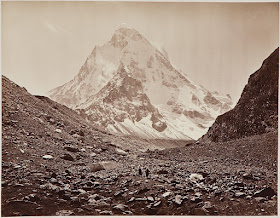SAMUEL BOURNE ( 1834-1912)
Shivling / Gangotri Group (6, 543m- 21, 4671ft)
India
In Moira, South of the Gangootri Glacier, India, albumen silver print from a glass negative, 1867,
Fogg Museum / Harvard Museums
About the photo
The view is taken from the remote Gangotri Glacier in Uttarakhand, near the present-day border of India and China. 'Samuel Bourne, the bank clerk and amateur photographer, arrived in India in 1863 during the early years of commercial photography. Photographs taken during three expeditions to Kashmir and the Himalayas between 1863 and 1866 demonstrate his ability to combine technical skill and artistic vision. These views display a compositional elegance which appealed to Victorian notions of the ‘picturesque’; strategically framed landscapes of rugged mountain scenery, forests, rivers, lakes and rural dwellings.
Copies of this spectacular and very early photograph of the Himalayas by pioneer photographer Samuel Bourne are held in the collections of the Fogg Museum, Harvard University (2.2002.112), Duke University Library (as part of RL.00130), and the British Library (94/4 25).
The photographer
Samuel Bourne was a British photographer known for his prolific seven years' work in India, from 1863 to 1870. Together with Charles Shepherd, he set up Bourne & Shepherd first in Shimla in 1863 and later in Kolkata (Calcutta). The company closed only two years ago, in June 2016 !
Bourne spent six extremely productive years in India, and by the time he returned to England in January 1871, he had made approximately 2,200 fine images of the landscape and architecture of India and the Himalayas. Working primarily with a 10x12 inch plate camera, and using the complicated and laborious Wet Plate Collodion process, the impressive body of work he produced was always of superb technical quality and often of artistic brilliance. His ability to create superb photographs whilst travelling in the remotest areas of the Himalayas and working under the most exacting physical conditions, places him firmly amongst the very finest of nineteenth century travel photographers.
On 29 July 1863, he left Simla on the first of his three major Himalayan photographic expeditions. With a retinue of some 30 porters to carry his equipment, he travelled across the Simla Hills to Chini, in the Valley of the Sutlej River, 160 miles north-east of Simla, and spent some time photographing in the Chini-Sutlej River area, before heading up to the borders of Spiti, and returning to Simla on 12 October 1863, with 147 fine negatives.
In 1867, Bourne journeyed on up to the Gangotri Glacier (see photo above). There he went on to photograph one of the prime sources of the Ganges, as it issued from the mouth of the glacial ice cave at Gaumukh. His return journey took in Agra, Mussoorie, Roorkee, Meerut and Naini Tal, and he arrived back in Simla, again in time for Christmas! He wrote extensively about his travels in the Himalayas (one of the very few photographers in India to do so), in a long series of letters, which appeared in The British Journal of Photography, between 1863 and 1870.
The mountain
Shivling ( 6, 543m- 21, 4671ft) is a mountain in the Gangotri Group of peaks in the western Garhwal Himalaya, near the snout of the Gangotri Glacier. It lies in the northern Indian state of Uttarakhand, 6 kilometres (4 mi) south of the Hindu holy site of Gaumukh (the source of the Bhagirathi River). Its name refers to its status as a sacred symbol -Shiva Linga. While not of locally great elevation, it is a dramatic rock peak.
Shivling ( 6, 543m- 21, 4671ft) is a mountain in the Gangotri Group of peaks in the western Garhwal Himalaya, near the snout of the Gangotri Glacier. It lies in the northern Indian state of Uttarakhand, 6 kilometres (4 mi) south of the Hindu holy site of Gaumukh (the source of the Bhagirathi River). Its name refers to its status as a sacred symbol -Shiva Linga. While not of locally great elevation, it is a dramatic rock peak.
Shivling forms the western gateway for the lower Gangotri Glacier, opposite the triple-peaked Bhagirathi massif. It lies on a spur projecting out from the main ridge that forms the southwest side of the Gangotri Glacier basin; this ridge contains other well-known peaks such as Bhagirathi, Thalay Sagar and Meru. It was also called Mahadeo Ka Linga or (Mahadev Ka Linga) and "Matterhorn Peak" by early European visitors because of its similarity in appearance to that Alpine peak.
Appearing as a single pyramid when seen from Gaumukh, Shivling is actually a twin-summitted mountain, with the northeast summit being slightly higher than the southwest summit. Between Gaumukh and Shivling lies the Tapovan meadow, a popular pilgrimage site due to its inspiring view of the mountain.
Shivling is well-defended on all sides by steep rock faces; only the west flank has a moderate enough slope for snow accumulation.
After British exploration of the Gangotri Glacier in 1933, a German expedition led by R. Schwarzgruber climbed nearby peaks and did a reconnaissance of Shivling in 1938. They reported "no feasible route" on the mountain due to its steepness and the threat of falling seracs.
Shivling was first climbed on 3 June 1974 via the west ridge, by a team from the Indo-Tibetan Border Police, led by Hukam Singh.
2018 - Wandering Vertexes...
Un blog de Francis Rousseau
